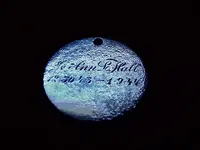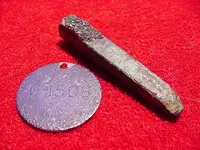Actually, birth and death records from the 1800s are plentiful, but not in the government archives. These happenings were recorded in family Bibles and written histories or journals. Land records (sales and titles) were meticulous, but alas were burned when courthouses burned. The birth and death of a child would only have been recorded in a family momento, such as the Bible. Or the tale passed on from one generation to another. This is where genealogy records come in, and programs such as Ancestry.com. The mormons have a wealth of knowledge stored in Salt Lake City, but it is accessible to the general public. I find the ancestry.com lead to be promising, but not positive proof. Continued efforts to locate the poster of that information might yield more answers. "Where did she get this information" is a good beginning if she is ever located (the posters are almost always women).
The birth and death of a baby in the mid-1800s would have been a quiet happening to the general public. It happened every day. What makes this particular one known is the small tag found with her name and dates on it. Do not look to find information on her in a public record (government), especially if she was born and buried at sea, unless you happen to get lucky and find the ship's record books in some historical organization.
In my small town in Louisiana, birth and death records began to be kept only in the early 1900s, even though the area had been settled for almost a century. The newspaper began about the same time. Earlier records are very sketchy. People buried their dead in their own backyards and fields. It was not a government-controlled activity as it is now. In my genealogy efforts, I still scour fields for graves of distant relatives, one of which was "marked with a bed post."
I still find this very intriguing. Even if you never learn more, you know that she existed and when, if not where.
NOODLE







 After he realized it may be worth something, he gave it to a diver friend who mailed it to someone who mailed it out of town, who mailed it back and said it was indeed an old infant female grave marker for a coffin box on a ship Row-G/ aisle 15 area #6, but he ruined it by sanding it. Well this is all too much and nothing verified. I took it back and with nothing to lose I polished it with silver polish which took the scratches out and gives it the shiny look it has today. I learned how to use a computer and found this forum which I thought was my best bet for identification. Now you know the whole story.
After he realized it may be worth something, he gave it to a diver friend who mailed it to someone who mailed it out of town, who mailed it back and said it was indeed an old infant female grave marker for a coffin box on a ship Row-G/ aisle 15 area #6, but he ruined it by sanding it. Well this is all too much and nothing verified. I took it back and with nothing to lose I polished it with silver polish which took the scratches out and gives it the shiny look it has today. I learned how to use a computer and found this forum which I thought was my best bet for identification. Now you know the whole story.